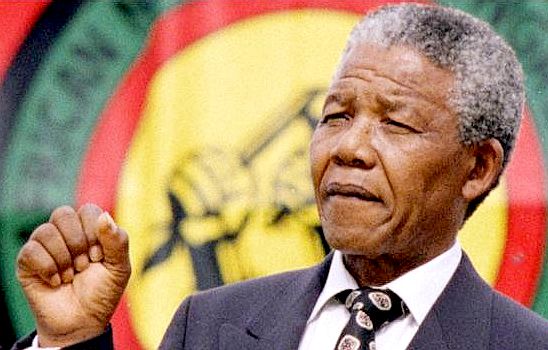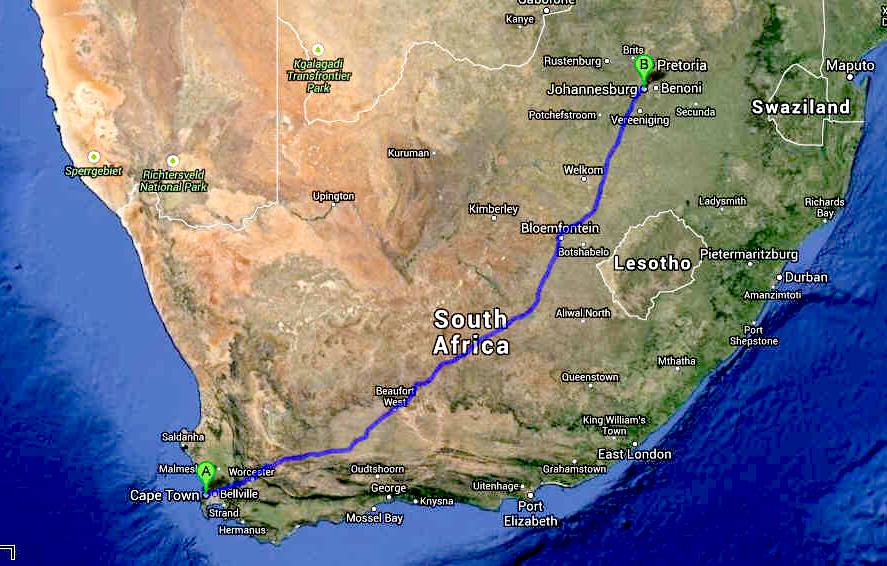CANNONBALL
INTERNATIONAL EV SERIES
The
Cannonball International EV Run™ series is for battery or hydrogen fuel cell powered
electric vehicles that are based on ordinary production vehicle running
gear and must be capable of carrying at least one passenger. They may be solar
assisted, provided that the solar panel area does not exceed four square
meters - a rule that may be relaxed in subsequent years as we learn from experience. See
the full Cannonball EV rules HERE.
These
rules are designed to promote the development of an international EV infrastructure, as a means of accelerating the transition from IC
engines to clean electric motors, especially in countries that do not
have abundant sunshine, where support for non-solar assisted
electric vehicles is all the more important.
CAPE
TOWN to LOUIS TRICHARDT -
TRANS-S
AFRICA CANNONBALL EV RUN SUGGESTED STOPS
|
START |
CAPE
TOWN |
WESTERN
CAPE |
KILOMETERS |
MILES |
|
1st
STOP |
Worcester |
Western
Cape |
113 |
70 |
|
2nd
STOP |
Laingsburg |
Western Cape |
264 |
163 |
|
3rd
STOP |
Beaufort
West |
Western
Cape |
462 |
287 |
|
4th
STOP |
Hanover |
Northern Cape |
703 |
436 |
|
5th
STOP |
Colesberg |
Northern Cape |
778 |
490 |
|
6th
STOP |
Bloemfontein |
Free State |
1,001 |
622 |
|
7th
STOP |
Kroonstad |
Free State |
1,211 |
752 |
|
8th
STOP |
Johannesburg |
Gauteng |
1,398 |
868 |
|
9th
STOP |
Mokopane |
Limpopo |
1,664 |
1,034 |
|
FINISH |
LOUIS
TRICHARDT |
LIMPOPO |
1,827 |
1,135 |
GOOGLE
SUGGESTED ROUTE - Driving directions
22 HRS
(This route has tolls)
Cape Town
- South Africa
1. Head southeast on Darling St toward Parade St -
350 m
2. Slight left onto Sir Lowry Rd -
240 m
3. Take the 1st left onto Christiaan Barnard St -
1.1 km
4. Turn right onto the N1/Table Bay Boulevard ramp to Paarl -
500 m
5. Merge onto N1
Partial toll road. Go through 1 roundabout -
534 km
6. Slight right onto N1/N12.
Continue to follow N1 -
239 km
7. Continue straight to stay on N1.
Partial toll road -
608 km
8. Take exit 67 to merge onto N12/N12 Southern Bypass toward M1/Johannesburg/O R Tambo International
Airport/Emalahleni (Toll road) -
3.1 km
9. Take exit 391 to merge onto M1 toward Johannesburg -
7.8 km
10. Take exit 10 on the right to merge onto Francois Oberholzer Fwy/M2 toward Stad/City -
1.3 km
11. Take the Rissik Street exit toward M9/Johannesburg -
300 m
12. Take exit 124 to stay on N1 toward Pretoria
E/Polokwane.
Partial toll road -
134 km
13. Turn left to stay on N1
(Partial toll road) -
138 km
14. Continue onto R101 -
2.7 km
15. At the roundabout, take the 2nd exit onto Grobler St/R101
Continue to follow Grobler St -
1.3 km
16. Turn left onto Mark St -
1.3 km
17. Slight right onto Landdros Mare St
- 8.6 km
16. Continue onto Louis Trichardt
-
1.5 km
18. Continue onto N1 -
97.1 km
19. Turn left onto Rissik St
-
1.4 km
20. Turn right onto Krogh St
-
8 m
Louis Trichardt - South Africa
CANNONBALL
INTERNATIONAL OFFICIAL
ROUTES
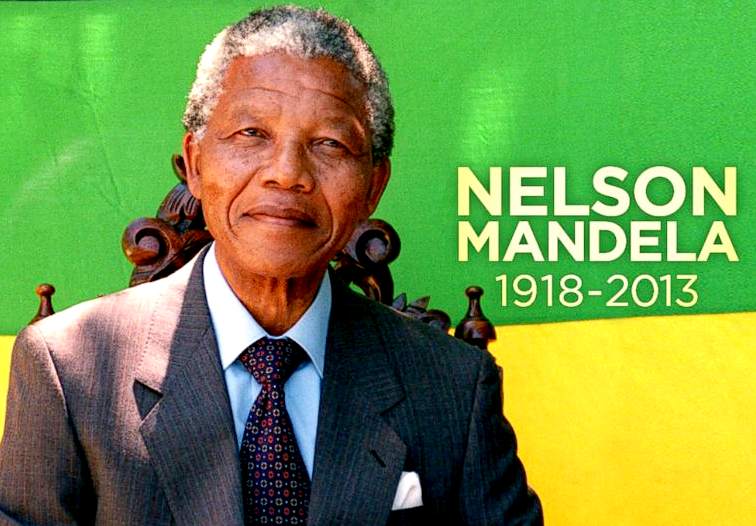
NELSON
MANDELA - 18 July 1918 to 5 December 2013
Nelson Rolihlahla Mandela
was a South African anti-apartheid revolutionary, politician and philanthropist.
he was President of South Africa from 1994 to 1999, and South Africa's first black chief
executive; the first elected in a fully representative democratic election. His government focused on dismantling the legacy of apartheid through tackling
institutionalized racism, poverty and
inequality, and fostering racial reconciliation. Politically an African nationalist and democratic socialist, he served as President of the African National Congress (ANC) from 1991 to 1997. Internationally, Mandela was Secretary General of the Non-Aligned Movement from 1998 to 1999.
Mandela attended the Fort Hare University and the University of
Witwatersrand, where he studied law. Living in Johannesburg, he became involved in anti-colonial politics, joining the ANC.
He became a founding member of its Youth League. After the South African National Party came to power in 1948, he rose to prominence in the ANC's 1952 Defiance Campaign, was appointed superintendent of the organisation's
Transvaal chapter and presided over the 1955 Congress of the People. Working as a lawyer, he was repeatedly arrested for seditious activities and, with the ANC leadership, was unsuccessfully prosecuted in the Treason Trial from 1956 to 1961. He secretly joined the South African Communist Party
(SACP) and sat on its Central Committee. Although committed to non-violent protest, with the SACP he co-founded the militant Umkhonto we Sizwe (MK) in 1961, leading a sabotage campaign against the apartheid government. In 1962, he was arrested, convicted of conspiracy to overthrow the state, and sentenced to life imprisonment in the Rivonia Trial.
Mandela served 27 years in prison
on Robben Island, in Pollsmoor Prison and Victor Verster Prison. An international campaign lobbied for his
release that succeeded in 1990, during a time of civil strife. Mandela joined negotiations with President F. W. de Klerk to abolish apartheid and establish multiracial elections in
1994. He led the ANC to victory and became South Africa's first black president. He published his autobiography in 1995. During his tenure in the Government of National Unity he invited other political parties to join the
cabinet and promulgated a new constitution.
Nelson Mandela created the Truth and Reconciliation Commission to investigate past
human rights abuses.
Continuing the former government's liberal economic policy, his administration also introduced measures to encourage land reform,
and expand healthcare services. He declined to run for a second term, and was succeeded by his deputy, Thabo
Mbeki. Mandela became an elder statesman, focusing on charitable work in combating poverty and
HIV/AIDS through the Nelson Mandela Foundation.
Mandela was a controversial figure for much of his life. Denounced as a communist terrorist by critics, he nevertheless gained international acclaim for his activism, having received more than 250
honours, including the 1993 Nobel Peace
Prize, the US Presidential Medal of Freedom, and the Soviet Order of Lenin. He is held in deep respect within South Africa, where he is often referred to by his Xhosa clan name,
Madiba, or as Tata ("Father"); he is rightly described as the "Father of the Nation".

ABOUT
SOUTH AFRICA
The Republic of South Africa, is a country located at the southern tip of Africa. It has 2,798 kilometres (1,739 mi) of coastline that stretches along the South Atlantic and Indian oceans. To the north lie the neighbouring countries of Namibia, Botswana and
Zimbabwe; to the east are Mozambique and Swaziland; and within it lies Lesotho, an enclave surrounded by South African territory. South Africa is the 25th-largest country in the world by land area, and with close to 53 million people, is the world's 24th-most populous nation.
South Africa is a multiethnic society encompassing a wide variety of cultures, languages, and religions. Its pluralistic makeup is reflected in the constitution's recognition of 11 official languages, which is among the highest number of any country in the world. Two of these languages are of European origin: English and Afrikaans, the latter originating from Dutch and serving as the first language of most white and coloured South Africans. Though English is commonly used in public and commercial life, it is only the fourth most-spoken first language.
About 80 percent of South Africans are of black African ancestry, divided among a variety of ethnic groups speaking different Bantu languages, nine of which have official status. The remaining population consists of Africa's largest communities of
European, Asian, and multiracial ancestry. All ethnic and linguistic groups have political representation in the country's constitutional democracy, which comprises a parliamentary republic and nine provinces. Since the end of apartheid, South Africa's unique multicultural character has become integral to its national identity, as signified by the
Rainbow Nation concept.
South Africa is ranked as an upper-middle income economy by the World Bank, and is considered to be a newly
industrialized country. Its economy is the largest and most developed in Africa, and the 28th-largest in the world. In terms of purchasing power parity, South Africa has the seventh-highest per capita income in Africa, although poverty and inequality remain widespread, with about a quarter of the population unemployed and living on less than
US$1.25 a day. Nevertheless, South Africa has been identified as a middle power in international affairs, and maintains significant regional influence.
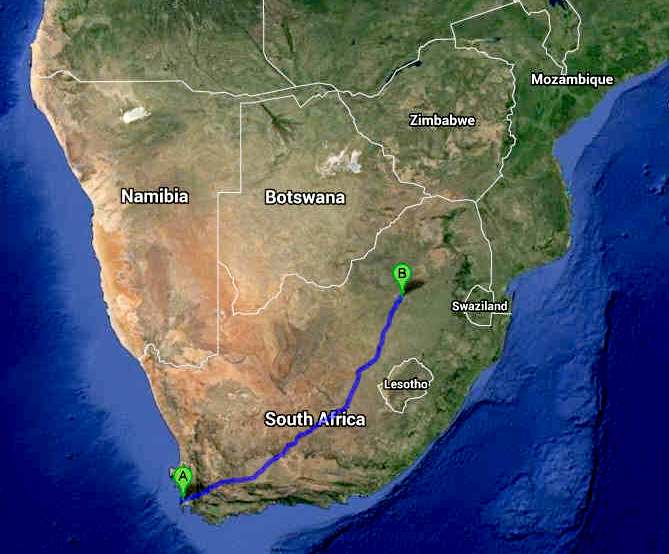
CONSERVATION
South Africa has lost a large area of natural habitat in the last four decades, primarily due to overpopulation, sprawling development patterns and deforestation during the nineteenth century. The original temperate forest found by the first European settlers was exploited ruthlessly until only small patches remained. Currently, South African
hardwood trees like Real Yellowwood (Podocarpus latifolius), stinkwood (Ocotea bullata), and South African Black Ironwood (Olea laurifolia) are under government protection. Statistics from South African National Parks show a record 333
rhinos have been killed in 2010.
Climate change is expected to bring considerable warming and drying to much of this already semi-arid region, with greater frequency and intensity of extreme weather events such as
heatwaves, flooding and drought. According to computer generated climate
modeling produced by the South African National Biodiversity Institute parts of southern Africa will see an increase in temperature by about one degree Celsius along the coast to more than four degrees Celsius in the already hot hinterland such as the Northern Cape in late spring and summertime by 2050.
Drought, increased intensity and frequency of fire and climbing temperatures are expected to push many rare species towards extinction.
For these reasons, South Africa will benefit significantly as electric
vehicles gain in popularity - so reducing global warming.

ECONOMY
South Africa has a mixed economy, the largest in Africa in terms of both nominal GDP (at $375.944 billion) and GDP at purchasing power parity (at $608.804 billion). It also has a relatively high GDP per capita compared to other countries in Sub-Saharan Africa ($11,750 at PPP as of 2012). Despite this, South Africa is still burdened by a relatively high rate of poverty and unemployment, and is also ranked in the top 10 countries in the world for income inequality, measured by the Gini coefficient. Unlike most of the world's poor countries, South Africa does not have a thriving informal economy; according to OECD estimates, only 15% of South African jobs are in the informal sector, compared with around half in Brazil and India and nearly three-quarters in Indonesia. The OECD attributes this difference to South Africa's widespread welfare system. World Bank research shows that South Africa has one of the widest gaps between per capita GNP versus its Human Development Index ranking, with only Botswana showing a larger gap.
After 1994 government policy brought down inflation, stabilised public finances, and some foreign capital was attracted, however growth was still subpar. From 2004 onward economic growth picked up significantly; both employment and capital formation increased.
South Africa is a popular tourist destination, and a substantial amount of revenue comes from tourism. Illegal immigrants are involved in informal trading. Many immigrants to South Africa continue to live in poor conditions, and the immigration policy has become increasingly restrictive since 1994.
Principal international trading partners of South Africa, apart for other African
countries, include Germany, the United
States, China,
Japan, the United Kingdom and
Spain.
The South African agricultural industry contributes around 10% of formal employment, relatively low compared to other parts of Africa, as well as providing work for casual labourers and contributing around 2.6% of GDP for the nation. Due to the aridity of the land, only 13.5% can be used for crop production, and only 3% is considered high potential land.
In August 2013, South Africa was ranked as the top African Country of the Future by FDi magazine based on the country's economic potential, labour environment, cost-effectiveness, infrastructure, business friendliness, and Foreign direct investment Strategy.
The FSI ranks South Africa as the 36th safest tax haven in the world, ahead of the
Philippines but behind the Bahamas.
South Africa has cultivated a burgeoning astronomy community. It hosts the Southern African Large Telescope, the largest optical telescope in the southern hemisphere. South Africa is currently building the Karoo Array Telescope as a pathfinder for the €1.5 billion Square Kilometer Array project. On 25 May 2012 it was announced that hosting of the Square Kilometer Array Telescope will be split over both the South African and the
Australia/New Zealand sites.
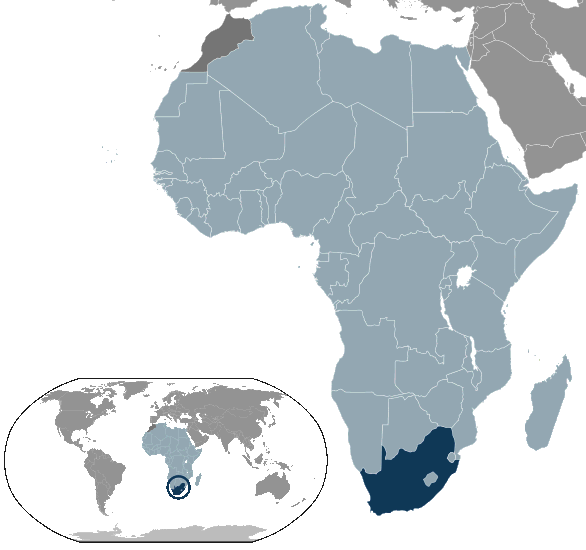
LINKS:
http://en.wikipedia.org/wiki/South_Africa
http://www.mile-to-km.com/km-to-miles.php
http://www.worldsolarchallenge.org/
http://www.discovery-campervans.com.au/adelaidedarwin.php
http://www.familyonabike.org/other%20info%20pages/awards.html
http://www.endtoenders.co.uk/
https://maps.google.com/
VAUXHALL
AMPERA endurance ev attempt 2010_ampera_e-revs
http://www3.imperial.ac.uk/
http://www3.imperial.ac.uk/newsandeventspggrp/imperialcollege/newssummary/news_27-5-2010-12-26-15
http://www.formaplex.com/news/formaplex-launches-electric-car-world-record-attempt/
http://www.engadget.com/2010/05/31/racing-green-endurance-srzero-electric-car-to-make-16-000-mile-t/
http://www.rideacrossbritain.com/packages/end-to-end/
http://www.discoveradventure.com/challenges/land-s-end-to-john-o-groats-cycle
http://en.wikipedia.org/wiki/Land%27s_End_to_John_o%27_Groats
An
event for adventure
capitalists
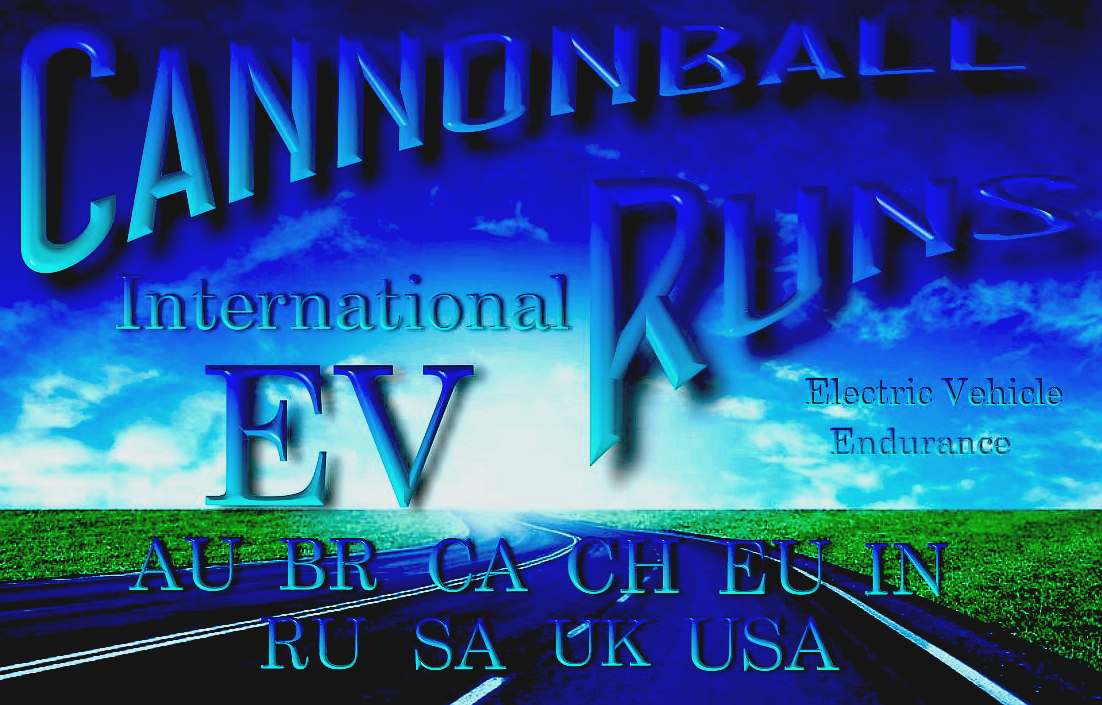
It's
about time we had an EV compatible with battery or hydrogen fuel cell
technology. The Ecostar DC50 by Bluebird Marine Systems Ltd may well be
the vehicle that changes all that from 2015.
